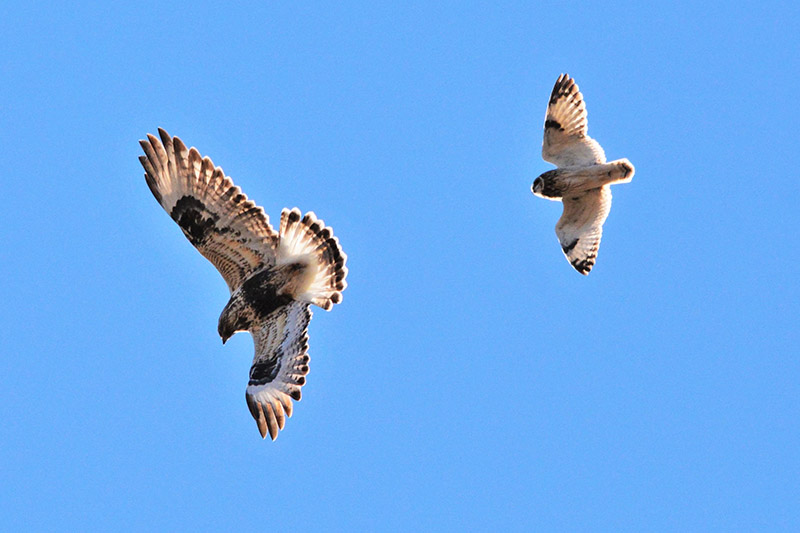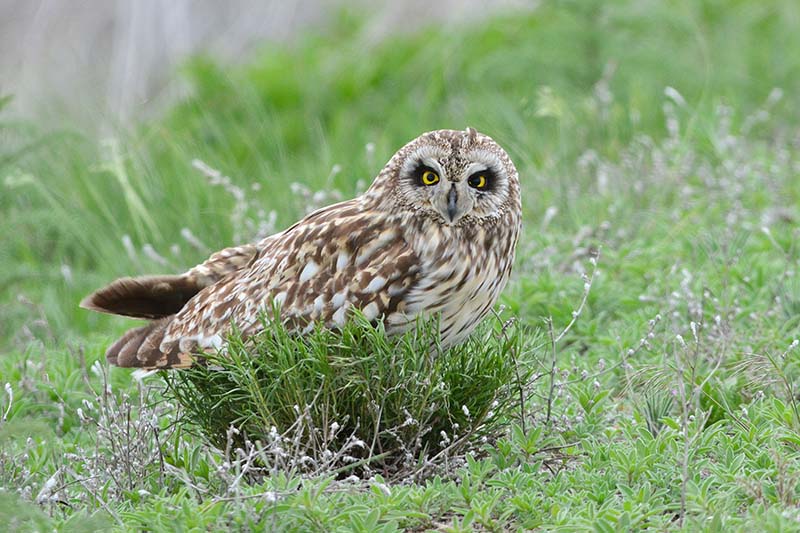The flight of the owls
Published at | Updated at
The slow erratic wing beats, with distinctive white wristbands on the wings, indicated the long-winged bird was a Short-eared Owl as it drifted over the summer dried marsh grass of Camas National Wildlife Refuge.
Soon the owl was joined by another one, a dark young inexperienced hunter. As the two worked the edge of a dried up pond, the adult caught a hapless rodent for the youngster’s breakfast.
Short-eared Owls have a body length of about 15 inches compared to their 42 inch wing span. With the slow, deep, rowing wing beats, their flight pattern has been described as that of a moth. Often times they will glide in search for prey without a wing beat over long distances, while only a few feet off the ground.
These two were part of several families of short-eared that have called the refuge home for the past year.
One evening last spring seven pair of these fliers were actively displaying to attract a mate. Their courtship was a spectacular aerial display.
Males show off by making rhythmic and exaggerated wing beats resembling the “clapping” of wings under their body. At times couples will engage in flight, locking talons and falling to the ground with the male holding his wings aloft. It is a show well worth the time to visit an area where numerous pairs have homesteaded.
The flight pattern and the wing colors of this medium sized owl are their most identifying features from a distance. As it skims over the grassland mixed with sagebrush, observers can easily identify its buff-white wing patches and dark crescent under wing.
Even though flight of the short-eared owl looks awkward at times, it can hover over prey for an extended period time even while facing into a wind.
Barely visible most of the time, the short ears are actually hair tufts used to attract other short-ears and warn of encroaching competitors.
The wet prairie habitat of the Camas NWR is prime territory for both migrants and year around residents. Migrants will increase the population of these beautiful bird in the fall and spring as they travel to and from their nesting areas.
“This year we have had more of these owls than I have seen any other time in my seven years here,” Brian Wehausen, manager of the refuge said. “Most of them left a couple of weeks ago, but we still have plenty of rodents for them to feed on.”
They feed on a variety of small mammals and birds. Voles, deer mice, moles and ground squirrels are easy prey for them. Songbirds and occasional game birds also will become breakfast or supper for them.
This species of owls is diurnal, mostly active during the early morning or late evening that brings them into contact with one of their more fierce competitors, the Northern Harrier. Both species inhabit the same areas and compete for the same food. Often times they can be seen dive bombing each other while hunting.
Being ground nesters, unlike most owls, the Short-eared Owls have poor reproduction success. Skunks, coyotes, ravens, crows and fox take a large toll on the eggs and small owlets. Other raptors often will try to pick off owlets before they are fully fledged.
After hatching, the chicks grow very rapidly and fledge in four weeks allowing a pair to attempt to raise two broods each year. At Camas last year, a pair was successful in raising two sets of two.
Good places to observe the Short-eared Owl are the marshy areas along the Snake River where the wetlands meet the sagebrush and grassland. Last spring the Sand Creek Road, north of the St. Anthony Sand Dunes as well as Market Lake and the CPR land between Teton City and Tetonia had large populations of displaying owls. Morning and evening are the best times to intercept them while they are hunting.
One might even see the beautiful flight patterns of Short-eared owls courting, attacking game birds or harassing other raptors that come too close to their chicks.
Living the Wild Life is brought to you by The Healing Sanctuary.







